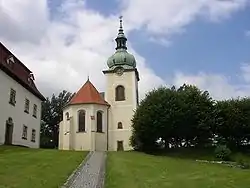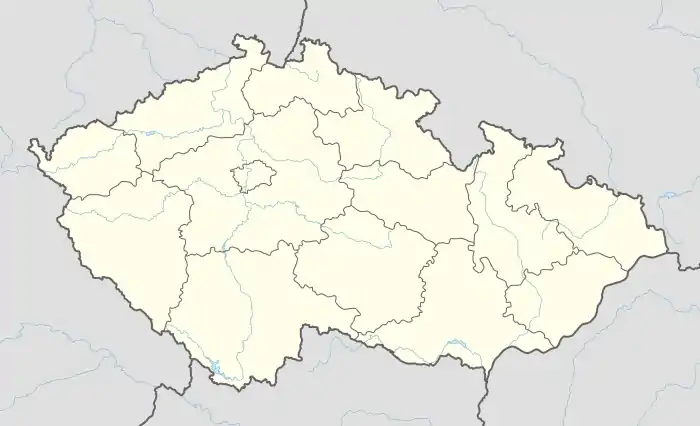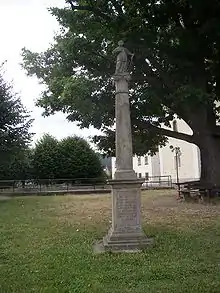Jiřetín pod Jedlovou
Jiřetín pod Jedlovou (German: Sankt Georgenthal) is a village and municipality (obec) in Děčín District in the Ústí nad Labem Region of the Czech Republic.
Jiřetín pod Jedlovou | |
|---|---|
Municipality | |
 Holy Trinity Church | |
 Flag  Coat of arms | |
 Jiretin pod Jedlovou DC CZ | |
 Jiřetín pod Jedlovou Location of Jiřetín pod Jedlovou in Czech Republic | |
| Coordinates: 50°52′28″N 14°34′26″E | |
| Country | |
| Region | |
| District | Děčín |
| Area | |
| • Total | 11.21 km2 (4.33 sq mi) |
| Elevation | 458 m (1,503 ft) |
| Population (2017) | |
| • Total | 652 |
| • Density | 58/km2 (150/sq mi) |
| Postal code | 407 56 |
| Website | http://www.jiretin.cz/ |
The municipality covers an area of 11.21 square kilometres (4.33 sq mi), and has a population of 652.[2]
Jiřetín pod Jedlovou lies approximately 30 kilometres (19 mi) north-east of Děčín, 45 km (28 mi) north-east of Ústí nad Labem, and 89 km (55 mi) north of Prague.
People[3]
- Johann Birnbaum (1793 – 1872), painter
- Franz Anton Ernst (Czech: František Antonín Ernst;[4] 1745 – 1805), composer
- Anton Donat (1746 – ?), painter
- Johann Chrystostomus Anton Eiselt (1814 – 1887), abbot
- Johann Aloys Miksch (1765 – 1845), singer[5]
- František Fišer (1926 – 1983), historian
- Edmunda Maria Anna May (Czech: Edmunda Maria Anna Mayová;[3] 1805 – ?), abbottess
- Josef Pietsch (1810 – 1866), priest
- Wenzel Salomon (1874, Jiřetín pod Jedlovou – 1953), painter
- Gottfried Ließner (? – 1787), catholic priest
- Josef Sieber (? – 1850), priest
Etymology
In German, the name for Jiřetín pod Jedlovou is Sankt Georgenthal which translates to Saint George in Oudolia. The town was founded in 1539 by Jiří z Šlejnic, therefore it was entrusted to the protection of St. George and was named after its patron. The Czech name was created in 1949 from the name of Jiří according to older Czech geographic names. After 1945 the town was called Saint Jiretin for a short period of time. In 1949 the town got a distinction under Jedla for differentiation from the other Jiřetínů.[6]
History
In 1983, The Garden of House No. 212 states that the oldest evidence of a man's stay in Jiřetín. The commemorative coin of Roman Emperor Claudius Gothicus, who ruled between 268 and 270, was founded and casted as Quintillus. Reflections on the Slavic settlement of this region since the end of the 6th century are merely fiction, and have no real basis.[7] In 1509 King Vladislaus II gave the town the right to exploit gold, silver, copper, lead, tin, and iron for twenty years. Mining attempts were first carried out in the Sýkoří valley below Tolštejn and in the Milířka pod Kozím Valley in the Lower Podluží cadastral area.[8]
City Foundation
The oldest documents of settlement around Jiřetín are medieval glassworks. The closest dated glassworks are located 1.5 km south of the village of Lesné on the Dolní Podluží cadastral area. Others are located in the middle of the Rozhled settlement opposite the resort of Slovan. The existence of the ironworks was dated to the end of the 13th century.[7]
According to available data, Jiřetín was founded in 1539, when a place was selected, and from 1548 to 1553 the mining town was set to a regular chessboard Floor plan. The town was built on an old Leipzig road that lined the eastern edge of the small town. The town of Jiřetín belongs to a group of upper towns, founded along the Saxony border. The base of Jiřetín is the exact square of the square from which the regular orthogonal network of streets unfolded. Central streets did not have a transit character, which was not at the expense of transportation availability. The long distance route was on the eastern edge of the city. Along the square and the streets were square quadratic blocks, each of which had three houses. Although all the houses in the town were wooden, it was never completely destroyed for this reason.[7]


The initial development of the town was influenced by the numerous advantages that arose from the founding privilege put together by Jiří z Šlejnic on November 12, 1554. The city had the usual basic rights; all homeowners were given the right to brew beer and sell it according to the Rumburk Brewing right, the right to care for, bread, and slaughter cattle, the freedom to trade and manage craft. They have been freed from all other Dominion and Customs. They had the right to vote for the city council, Purkmistr, and city government officials, even though the nobility insisted on their approval. The inhabitants of the city did not receive any land, only those on which their houses stood. However, they had the right to a free reference of their property and, above all, the privilege of free movement, which meant they had the right to leave and return to Jiřetín.[7] The privileges allowed a successful urban life to ensure successful mining. The main mining work in the 16th century was the hereditary adit of Saint Christopher, its entrance can be seen in front of the house of Jiřetín No. 252 in Křížová Street. The support of the authority was not limitless, a conditional extension of the mining privilege was envisaged. The privilege was extended in 1569 for another 15 years and in 1584 for another three years. Soon, however, mining fell. At the time of limiting mining activities, the estate was property of the law. In 1587, the inhabitants of the town were subject to salaries and duties.[7] On December 18, 1587, the town was granted privileges by Emperor Rudolf II. The city's privileges included two annual markets, St. George (April 24), and St. Martin's (November 11). In 1599, a plague epidemic broke out in the city, which killed 300 people.[9]
The church was built by the town's people of Jiřetín in 1587. The church was consecrated on 21 May 1612 and the first clergyman Joachim Schöfelder, the evangelical pastor of Dolní Podluží, became the first clergyman. In 1616, the priest moved from Dolní Podluží to Jiřetín.[7]
Hopes and prayers for ore deposits did not meet expectations. The path to life security led to guilds.[7]
In 1642, during the Thirty Years' War, the Swedes destroyed the nearby Tolštejn Castle. At the time of the re-Catholicization, according to the list of December 3, 1652, 108 people left from Jiřetín, Johann Krocker was the first to receive civic law in Dresden.
Thirty Years' War to 1945

Until the issue of the imperial patent on July 19, 1765, the city used high justice rights. The execution site was on Šibeniční hill.
After the Thirty Years' War, there were 29 desolate houses from 92 houses in Jiřetín. In 1656, Jiriethin's pastor stated that mines of gold, silver, copper, and also coal were put into operation. In 1750, the mining of ores was carried out in the hereditary cathedral of Saint Christopher on the Cross Mountain, in 1781 Štola Jan Evangelista was built. In 1681 he bought the rumby estate of Prince Anton Florian from Liechtenstein, whose family shared the destiny of Jiřetín until 1919. In 1804, after the destruction of the manipulation building, the ore had to be weighed into Saxon Freiberg, which was very wasteful, so the mining did not continue. The land Jedlová worked in the early 18th century Baroque glassworks. In 1805, the road used today was built over the Stožecké saddle. The junction under Jiřetín carries the unofficial name Na Mýtě, probably to prove that the old trade route, which led to toll collection in Tolštejn, was conducted here. In 1848 a national guard was formed in Jiřetín. In 1907, with regards to the reformation of the public administration, the abolition of the estate and the establishment of districts, it became part of the Rumburk district, later in the district of Varnsdorf. Since 1862 there has been a post office in Jiřetín.[7]
Josef Vítězslav Šimák wrote about Jiřetín pod Jedlovou:[7]
"Hory Jiřetínské kvetly však jen za požehnaného míru doby Rudolfinské, válkou třicetiletou zanikly a nevzkřísily se, ač pokusy o to dály se. Teprve nový průmysl, tkalcovský a soukenický, zvláště výroba sametů, potom sklářství, zavedené sem ta tišších dob ze sousedství, pomohl městečku a je dosud hlavním zdrojem výživy."
"The Jiřetínské Mountains bloomed, however, only for the blessed peace of the Rudolfinian period, the Thirty Years' War ceased and the thought did not pass, although there were attempts to do so. Only the new weaving industry, especially the production of velvet, then the glassmaking, were introduced here in the quietest neighborhoods, helping the town and is still the main source of nutrition."
The population of Jiřetín reached its highest in 1880. After the mid-19th century, due to diversion of the main road, and in relation to industrial and building development near Varnsdorf, Jiřetín stopped their Floor plan development. Only two buildings were built; the Shoreline building at the foot of the Cross Mountain, and the firearms building just next to it. At the beginning of the 20th century a new waterworks system was built. On September 8, 1909, electricity was introduced in Jiřetín. During the First World War, 71 South Moravian natives were killed.[7]
Demography
Population
| Year | Pop. | ±% p.a. |
|---|---|---|
| 1818 | 2,142 | — |
| 1830 | 2,460 | +1.16% |
| 1850 | 2,729 | +0.52% |
| 1869 | 3,392 | +1.15% |
| 1880 | 3,415 | +0.06% |
| 1890 | 3,379 | −0.11% |
| 1900 | 3,275 | −0.31% |
| 1910 | 3,172 | −0.32% |
| 1921 | 2,654 | −1.61% |
| 1930 | 2,961 | +1.22% |
| 1950 | 992 | −5.32% |
| 1961 | 1,039 | +0.42% |
| 1970 | 888 | −1.73% |
| 1980 | 773 | −1.38% |
| 1990 | 614 | −2.28% |
| 2000 | 575 | −0.65% |
| 2001 | 570 | −0.87% |
| 2008 | 591 | +0.52% |
| 2017 | 652 | +1.10% |
According to the census, on 1 November 1980, 773 people lived in Jiřetín pod Jedlovou, of whom 296 were men and 477 were women. The unusual ratio of men and women was caused by the fact that in Jiřetín there was a charity home for the religious, and there were also housed workers from Poland. A total of 543 citizens reported their Czech nationality, 140 Slovak, 72 German, 10 Polish, 5 Hungarian, and 3 Ukrainian. According to the census in 2001, Jiřetín pod Jedlovou had 570 inhabitants, of which 484 had Czech nationalities, 30 German, 25 Slovak and one citizen applied for Moravian nationality.[10]
 Age structure of inhabitants of Jiřetín pod Jedlovou village in 2011
Age structure of inhabitants of Jiřetín pod Jedlovou village in 2011
See also
- Horní Jiřetín municipality known in German as Obergeorgenthal
References
- "Obec Jiřetín pod Jedlovou: Územně identifikační registr ČR". www.uir.cz (in Czech). Retrieved 2 April 2018.
- "Počet obyvatel v obcích - k 1.1.2017 | ČSÚ". www.czso.cz (in Czech). Retrieved 3 April 2018.
- "Biografie osobností: Jiřetín pod Jedlovou". www.jiretin.cz (in Czech). Retrieved 3 April 2018.
- o., KP-SYS spol. s r. "Ernst, František Antonín, 1745-1805 - Bibliografie dějin Českých zemí". biblio.hiu.cas.cz (in Czech). Retrieved 3 April 2018.
- Infolytics, 7P (2 September 2017). "Suche". kalliope-verbund.info (in German). Archived from the original on 31 March 2016. Retrieved 3 April 2018.
- al., redakční rada Jaroslav Melichar ... [et (2008). Vlastivěda Šluknovského výběžku pro školy a veřejnost (in Czech) (1. vyd. ed.). Šluknov: Sdružení pro rozvoj Šluknovska. ISBN 978-80-254-1704-1.
- Smetana, Jan (1998). Jiřetín pod Jedlovou : 450 let města v Lužických horách (in Czech) (Vyd. 1 ed.). Jiřetín pod Jedlovou: Obec. ISBN 80-238-2811-8.
- Kühn, Jiří. "Jiřetín pod Jedlovou". www.luzicke-hory.cz (in Czech). Archived from the original on 9 August 2007. Retrieved 4 April 2018.
- "History of Jiřetín pod Jedlovou until 1989". jiretin.cz (in Czech). Archived from the original on 17 June 2009. Retrieved 3 April 2018.
- "Sčítání lidu, domů a bytů 2001 (Census, Houses and Flats 2001)". www.czso.cz (in Czech). Archived from the original on 5 November 2007. Retrieved 3 April 2018.
Expand
| Wikimedia Commons has media related to Jiřetín pod Jedlovou. |
